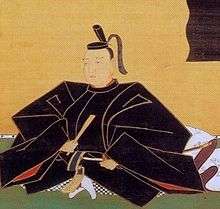Hosokawa Tadaoki
| Hosokawa Tadaoki | |
|---|---|
 Hosokawa Tadaoki | |
| Lord of Nakatsu | |
|
In office 1600–1602 | |
| Preceded by | none |
| Succeeded by | Ogasawara Nagatsugu |
| Lord of Kokura | |
|
In office 1602–1620 | |
| Preceded by | none |
| Succeeded by | Hosokawa Tadatoshi |
| Personal details | |
| Born | November 28, 1563 |
| Died | January 18, 1646 (aged 82) |
| Nationality | Japanese |
| Spouse(s) | Hosokawa Gracia |
Hosokawa Tadaoki (細川 忠興, November 28, 1563 – January 18, 1646) was a Japanese samurai warrior of the late Sengoku period and early Edo period.[1]
Early life
Tadaoki was the eldest son of Hosokawa Fujitaka.[2] He fought in his first battle at the age of 15. In that battle, he was in the service of Oda Nobunaga.
Daimyo
Tadaoki was given the Province of Tango in 1580. Soon after that, he married Hosokawa Gracia, the daughter of Akechi Mitsuhide. In 1582, Akechi Mitsuhide rebelled against Nobunaga and Nobunaga was killed. Akechi turned to Hosokawa Fujitaka and Hosokawa Tadaoki for help. They refused to help him, and Mitsuhide was defeated.
Tadaoki was present on Hideyoshi's side in the Battle of Komaki and Nagakute (1584) and the Odawara Campaign (1590), where he took part in the siege of Nirayama (Izu province) and later joined the main army outside Odawara. During the 1590s he became friends with Tokugawa Ieyasu (who had lent him money to assist in some debts owed Toyotomi Hidetsugu) and in 1600 sided with him against Ishida Mitsunari. In July Ishida had attempted to gain some leverage over those leaning towards Ieyasu by taking as hostages all those whose families were in Osaka Castle. This happened to include Tadaoki's wife - who was by now a Christian, baptized 'Gracia'. To avoid capture, Gracia ordered a servant to kill her and set fire to their quarters. While there is little reason to believe that Hosokawa was emotionally scarred by the incident, it was considered an appalling act of trickery, and served to drive Tadaoki - among others - into Ieyasu's camp.
At the Battle of Sekigahara (21 October 1600) Tadaoki commanded 5,000 men in the Tokugawa vanguard and clashed with the forces of Shima Sakon. He was awarded a fief in Buzen (Kokura, 370,000 koku) and went on to serve at the Siege of Osaka (1614–1615). He was succeeded by Hosokawa Tadatoshi (1586–1641), who was present at the Siege of Shimabara (1637–1638). In 1632 Tadatoshi received a huge fief in Higo (Kumamoto, 540,000 koku), where the Hosokawa family remained until 1871.
Retainers
See also
References
- ↑ 細川忠興 at Nihon jinmei daijiten; retrieved 2013-5-29.
- ↑ Nussbaum, Louis-Frédéric. (2005). "Hosokawa Tadaoki" in Japan Encyclopedia, p. 359.
External links
- Sengoku Biographical Dictionary Hosokawa Tadaoki
Further reading
- Sansom, George "A History of Japan", 1334-1615 Stanford 1961
- Berry,Mary Elizabeth "Hideyoshi" 1982
- Charles Ralph Boxer, "Hosokawa Tadaoki and the Jesuits, 1587-1645" in "Portuguese Merchants and Missionaries in Feudal Japan, 1543-1640", by Variorum Reprints (1986)
| Preceded by none |
Lord of Nakatsu 1600-1602 |
Succeeded by Ogasawara Nagatsugu |
| Preceded by none |
Lord of Kokura 1602-1620 |
Succeeded by Hosokawa Tadatoshi |
